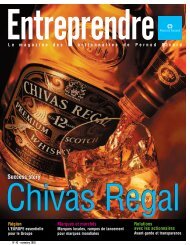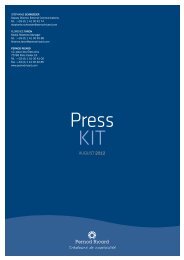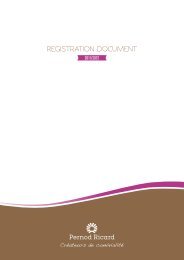Registration Document - Pernod Ricard
Registration Document - Pernod Ricard
Registration Document - Pernod Ricard
Create successful ePaper yourself
Turn your PDF publications into a flip-book with our unique Google optimized e-Paper software.
The fair value of the debt is determined for each loan by discounting<br />
future cash flows on the basis of market rates at the balance sheet<br />
date, adjusted for the Group’s credit risk. For floating rate bank debt,<br />
fair value is approximately equal to carrying amount.<br />
The market value of instruments recognised in the financial<br />
statements at the balance sheet date was calculated on the basis of<br />
available market data, using standard discounted cash flow methods.<br />
The disparity of valuation models implies that these valuations do not<br />
necessarily reflect the amounts that could be received or paid if these<br />
instruments were to be settled in the market.<br />
The methods used are as follows:<br />
◆ bonds: market liquidity enabled the bonds to be valued at their fair<br />
value;<br />
◆ other long-term financial liabilities: the fair value of other longterm<br />
financial liabilities is calculated for each loan by discounting<br />
future cash flows using an interest rate taking into account the<br />
Group’s credit risk at the balance sheet date;<br />
◆ derivative instruments: the fair value of foreign currency forwards<br />
and interest rate and foreign currency swaps was calculated using<br />
the market prices that the Group should pay or receive to settle<br />
these contracts.<br />
2. Risk management<br />
Management and monitoring of financial risks is performed by the<br />
Financing and Treasury Department, which has ten staff members.<br />
This department, which is part of the Group Finance Department,<br />
manages all financial exposures and prepares monthly reporting to<br />
the attention of General Management. It processes or validates all<br />
hedging transactions in the context of a programme approved by<br />
General Management.<br />
All financial instruments used hedge existing or forecast hedge<br />
transactions or investments. They are contracted with a limited<br />
number of counterparts who benefit from a first class rating from<br />
specialised rating agencies.<br />
Management of liquidity risk<br />
At 30 June 2009, cash and cash equivalents totalled €520 million. An<br />
additional €1,532 million of medium-term credit facilities with banks<br />
were confirmed and remained undrawn at this date. Group funding is<br />
provided in the form of long-term debt (syndicated loan, bonds, etc.)<br />
and short-term financing (commercial paper, bank overdraft, etc.)<br />
which provide adequate financial resources to ensure the continuity<br />
of its business. Net short-term financial debt was €383 million.<br />
In addition, the Group’s bank and bond debt contracts include<br />
covenants. Breaches of these covenants could force the Group to<br />
make accelerated payments. As of 30 June 2009, the Group was in<br />
c ompliance with the covenants (consolidated EBITDA/net financing<br />
cost and Net debt/consolidated EBITDA) under the terms of its<br />
syndicated loans.<br />
Similarly , while the vast majority of the Group’s cash surplus is placed<br />
with branches of global banks enjoying the highest agency ratings,<br />
it cannot be ruled out that these Group investments may experience<br />
reduced liquidity and severe volatility.<br />
ANNUAL CONSOLIDATED FINANCIAL STATEMENTS 4<br />
Notes to the annual consolidated fi nancial statements<br />
Management of currency risk<br />
The Group prepares its financial statements in euros and is therefore<br />
exposed to fluctuations against the euro of other currencies in which<br />
its assets and liabilities are denominated (asset risk) or in which it<br />
carries out its operations (transaction and currency translation<br />
risks).<br />
Although certain hedging strategies can limit exposure, there is no<br />
absolute protection against the impact of exchange rate movements.<br />
Regarding asset risk, financing foreign currency-denominated assets<br />
acquired by the Group with debt in the same currency provides natural<br />
hedging. This principle was applied to the acquisition of Seagram,<br />
Allied Domecq and Vin&Sprit assets denominated in American dollars<br />
and Japanese yen.<br />
Movements in currencies against the euro (notably the American<br />
dollar) may impact the nominal amount of these debts and the<br />
financial costs published in euros in the consolidated financial<br />
statements, and this could affect the Group’s reported results.<br />
Regarding operational risk, due to its international exposure, the<br />
Group faces currency risks related to transactions carried out by<br />
subsidiaries in a currency other than their functional currency.<br />
In all cases, the Group policy is to invoice end customers in the<br />
functional currency of the distributing entity. Currency exposure<br />
generated by intrag roup billings between producer and distributor<br />
subsidiaries are managed through a monthly centralisation and<br />
netting process. This process involves most countries whose<br />
currencies are freely convertible and transferable and whose<br />
domestic laws allow their participation. This system hedges against<br />
net exposure using forward exchange contracts.<br />
Residual risk is partially hedged using financial derivatives (forward<br />
buying, forward selling or options) to hedge certain or highly probable<br />
non-Group operating receivables and payables.<br />
Sensitivity analysis of financial instruments<br />
to currency risks<br />
Financial liabilities classified as hedges of a net investment are<br />
essentially sensitive to fluctuations in the American dollar; a 1%<br />
increase or decrease in the dollar/euro exchange rate would affect<br />
Group shareholders’ equity by +/-€18 million. This impact would be<br />
offset by change in the translated value of the net investment being<br />
hedged.<br />
Management of interest rate risk<br />
At the time the syndicated loans for the acquisition of Seagram and<br />
Allied Domecq assets were put in place, the Group exceeded the<br />
hedging obligation required by the banks. The hedging portfolio<br />
includes swaps and interest rate options in addition to fixed-rate<br />
debt.<br />
Analysis of the sensitivity of financial instruments<br />
to interest rate risks (impacts on the income<br />
statement):<br />
I REFERENCE DOCUMENT 2008/2009 I PERNOD RICARD 107<br />
◆<br />
◆<br />
a 50bp increase or decrease in (USD and EUR) interest rates would<br />
increase or reduce the cost of net financial debt by 4%;<br />
changes in the fair value of fair value hedges resulting from<br />
movements in the market rates of hedging and hedged instruments<br />
consist chiefly of:
















